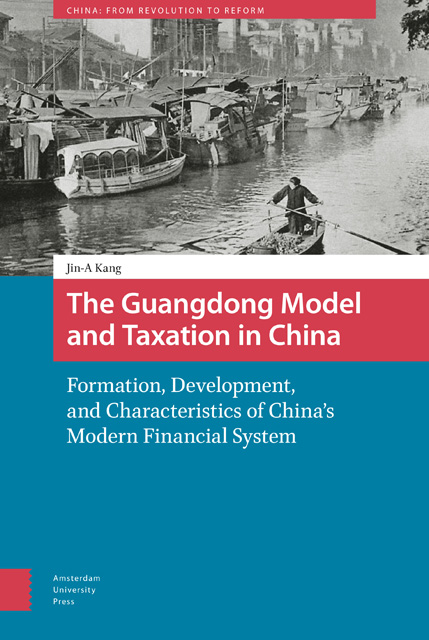 The Guangdong Model and Taxation in China
The Guangdong Model and Taxation in China Book contents
- Frontmatter
- Table of Contents
- Abbreviations
- Acknowledgments
- Introduction: The Modern Transformation of the Imperial Fiscal System: The Case of Provincial Finance in Guangdong
- Part 1 New Tax Revenues in Guangdong during the Republican Era
- Part 2 State-led Industrialization and the State Monopoly
- Part 3 Reform of Tax Collection
- Part 4 The Transition of the Modern Chinese Tax Structure in a Global Context
- Bibliography
- Glossary
- Index
4 - Special Taxes on Imported Rice
Published online by Cambridge University Press: 10 January 2023
- Frontmatter
- Table of Contents
- Abbreviations
- Acknowledgments
- Introduction: The Modern Transformation of the Imperial Fiscal System: The Case of Provincial Finance in Guangdong
- Part 1 New Tax Revenues in Guangdong during the Republican Era
- Part 2 State-led Industrialization and the State Monopoly
- Part 3 Reform of Tax Collection
- Part 4 The Transition of the Modern Chinese Tax Structure in a Global Context
- Bibliography
- Glossary
- Index
Summary
Abstract
The controversial success in raising revenue in the 1930s Guangdong was the Special Tax on Imported Rice. This issue highlights the centrallocal rivalry in taxation and inter-regional conflicting interests between Guangdong and the rest of China. People in Guangdong have struggled to resist any tax on imported rice since the 1920s. But, when the central government in Nanjing began to levy a tariff on imported rice to raise the slogan of “food self-sufficiency.” Chen Jitang regime in Guangzhou announced instead to charge the Special Tax on it. However, Guangdong merchants appealed that imported rice from Southeast Asia was not a “foreign rice” but a “national rice.” Finally, the food crisis in 1936 resulted in the tariff exemption to Guangdong province.
Keywords: Special Tax, Guangdong, imported rice, food, self-sufficiency
Food supply in Guangdong province
Since the middle of the Ming dynasty, Guangdong province had been known for running short of provisions. According to Lou Tongmao's calculation, which was used in 1936 for the Guangdong provincial government (hereafter, the GPG)'s policy-making, the average yearly non-glutinous and glutinous rice production in Guangdong province was about 131 million piculs. In comparison, the amount of polished rice circulating in the market was only 78.69 million piculs due to the 40 percent loss in rice processing. However, applying the average annual consumption of rice per capita as 3.5 piculs and multiplying it by the population of 33,461,320 (1936), total rice consumption in Guangdong province was 117,114,651.5 piculs, hence a shortfall of 28,424,651.5 piculs. Other contemporaneous data, from the Agriculture and Forestry Bureau in 1935, reported that the total arable land area of Guangdong province was 23,897,804 mu and yearly rice production was 113,046,249 piculs. Both data reveal a shortfall in the food supply within the province.
Table 4.1 below shows that the shortfall totaled 16,958,758 piculs, slightly less than the above calculation. In particular, the Chaozhou and Shantou areas were the most rice-deficient localities in the province.
The main strategy for filling this shortage was importing rice and grains from Southeast Asia (yangmi and yanggu).
- Type
- Chapter
- Information
- The Guangdong Model and Taxation in ChinaFormation, Development, and Characteristics of China's Modern Financial System, pp. 107 - 136Publisher: Amsterdam University PressPrint publication year: 2022
